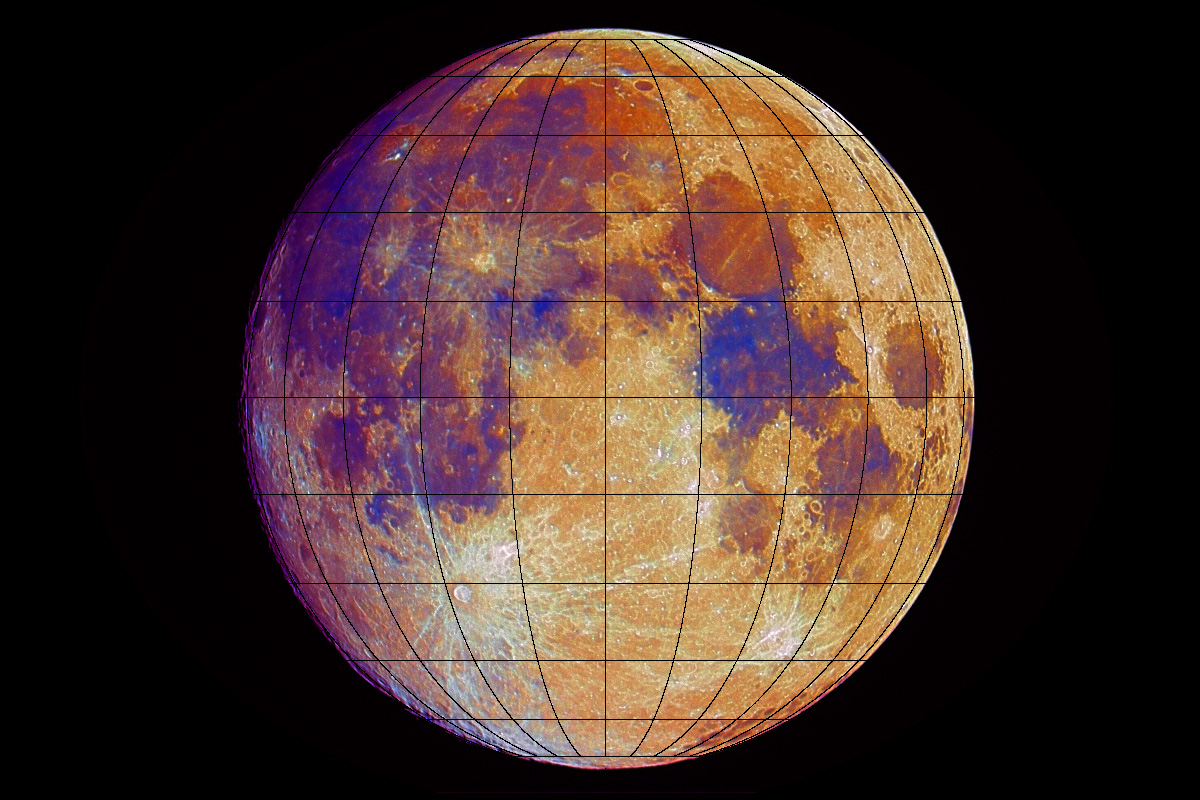ARCHIVE 2012INTRODUCTIONImaging from the worst place on Earth? Possibly! Welcome to my image blog from Lancashire, UK. Living in Lancashire does make imaging a challenge. Our incessant damp cloudy weather is legendary and coupled with light pollution probably as bright as can be found anywhere (I am 15 miles NW of the centre of Manchester) makes for testing times! Add to that flight path one with constant aeroplanes, which is why it has been suggested as possibly the worst place on Earth for imaging. Now the good news. With modern light pollution filters we can still produce excellent results - at least when the clouds clear - but of course we cannot match dark sites - I avoid looking at images from such sites as they are very depressing and un-representative of what the rest of us have to suffer! So if you too live in cloudy suburbia then I hope the following images offer some encouragement. I often shoot the luminance and the colour simultaneously - there are not enough clear spells to alow the luxury of shooting separately. Having two telescopes and two cameras is obviously essential for this - as is having a dome slot wide enough for both to have a clear line of sight. The luminance is usually taken with the RCOS + Apogee Alta and the colour Takahashi + Canon 40D. Despite their disparate focal lengths this works reasonably well as the Canon has 5 micron pixels (plate scale 2 arcsecs/pixel) and the Apogee 18 micron ones when binned 2x2 (plate scale 1.3 arcsecs/pixel). I find binning essential to maximise signal and improve the signal-to-noise ratio. The images are all taken from my back garden and appear in order of me processing them - we have plenty of cloudy nights for that. I use a combination of IRIS and Maxim for processing with final tweaks in Photoshop CS2. To get rid of the light pollution takes much trial and error. IRIS scores here with several options but processing often comprises many nights work - certainly always longer than the actual taking. The exception are images taken with an h-alpha filter which is a superb light pollution filter. It also permits imaging with strong Moonlight present - isn't it funny how it always seems to be clear at full Moon! |
DECEMBER 30th, 2012Abell Galaxy Group 2666 (NGC 7768 Group) Around 325 million light-years from home, this Abell cluster is one of the smaller ones. Some difference of opinion as to who discovered it - perhaps John Herschel but it was also observed by Lord Rosse in Ireland. It lies inside the Square of Pegasus. Just the middle part is recorded in my image, ie the area around the cluster's central elliptical cD galaxy NGC 7768. A feature of the group being the number of edge-on galaxies present. This was just a quickie image whilst I was waiting for the next target to rise. Image details: |
NGC 7768 Group |
DECEMBER 19th, 2012Sharpless Sh2-202, Van den Bergh 14 & 15 & Pazmino's Cluster Sharpless Sh2-202 is a very faint emission nebula (red) and just over 4 hours with a DSLR camera was simply not enough! However, the two reflection nebulae VDB 14 & 15 (towards the left and bluish) have recorded better. The pretty cluster above middle, right a bit, is Stock 23, also known as Pazmino's Cluster. These nebulae are located straddling the border between Cassiopeia and Camelopardalis. Image details: |
Sh2-202 |
DECEMBER 16th, 2012Heart & Soul Nebulae (Sh2-190 & 199) The Soul Nebula (left) is also known as the Baby Nebula and back in film days it was called the Foetus Nebula. The Heart Nebula (right) inludes IC1805. Located in Cassiopeia. Two nebulae that for once resemble their popular names. It took no less than 4 nights to get enough clear spells to image these objects. The Pentax lens can just fit them in but it is a tight squeeze. Wiil increase the exposures to 15 minutes next time. Image details: |
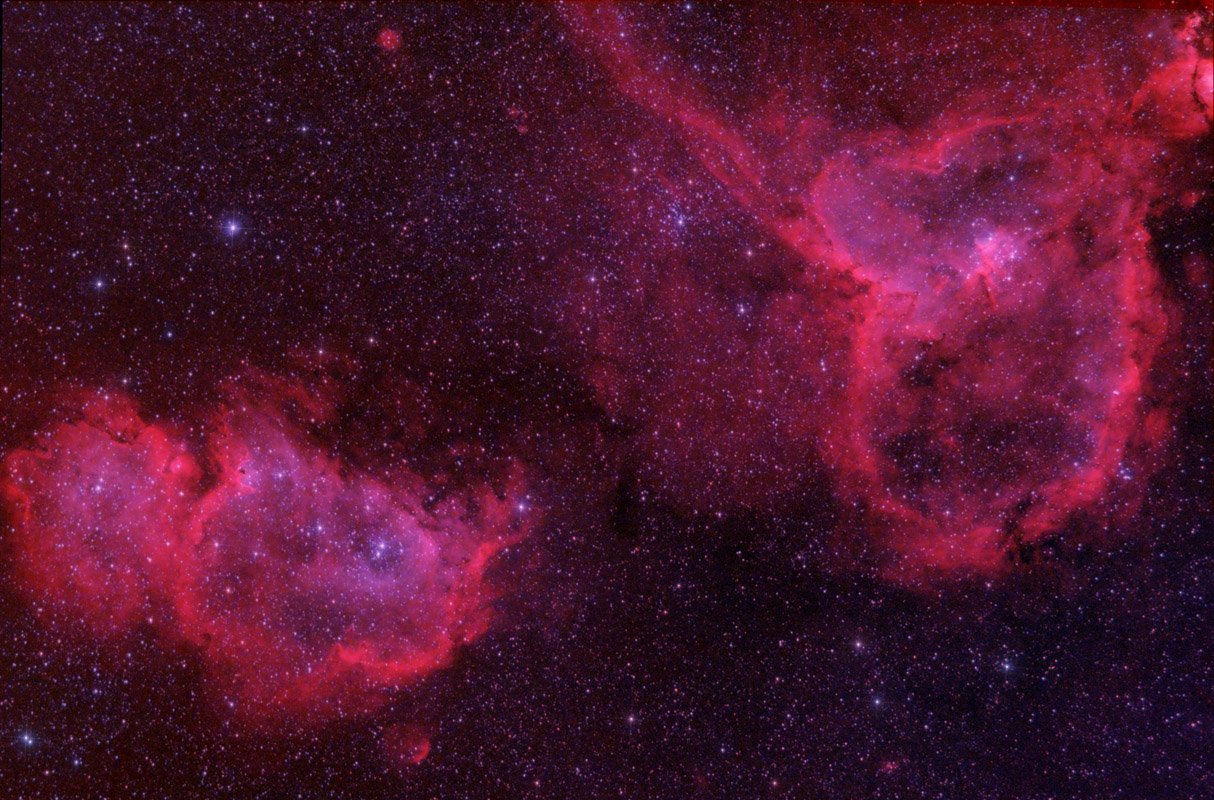 |
Heart and Soul Nebulae |
DECEMBER 12th, 2012Jupiter with a Celestron Celestar & Microsoft Lifecam Just like buses - two planetary images coming together. Don't worry I am not going to make a habit of it. With Jupiter better placed this year than it is going to be for several years to come then it was too good an opportunity to miss. Vintage Celestron Celestar C8 with a Microsoft Lifecam Cinema HD webcam. See Imaging>lifecam section for more details. Image details: |
Jupiter and the Great Red Spot (plus its junior partner). |
DECEMBER 10th, 2012Jupiter with an Aldi Mini-Dobsonian Telescope Something completely different! Aldi sold in the run up to Christmas a starter telescope branded National Geographic. Similar to the Celestron/Skywatcher first-scopes but of slightly longer focal length. The scope is 76 mm aperture with probably just a spherical mirror but does give some great views of brighter objects. It is a huge improvement on the usual starter telescopes and is much more beginner/child friendly. I tried imaging with my webcam to see what was possible with what is after all an un-driven telescope. These images are quite represenative of what can be expected in the eyepiece. The first one has Jupiter over-exposed so no detail evident. The second one I paid more attention to the exposure setting and, if you squint a bit, there is a hint of a belt(s). Image details: |
Jupiter and the Galilean Moons |
DECEMBER 2nd, 2012IC 1396 in Cepheus (Sh2-131) Although generally referred to IC1396 the full nebula is probably more accurately called Sh2-131. The IC entry refers to a cluster with nebulosity which is really the central area only. Herschel's Garnet Star is on the top (northern) edge. Returned to testing the Pentax lens this time fully open at f/2.8 for the H-alpha images. Whilst the lens was ok for the these processing proved a problem. I had done a few h-alpha images with a DSLR before but not realised that the flats were not working. However, in this case it was obvious something was amiss. What happens is IRIS (I use this for DSLR processing) could not deal with h-alpha flats or least couldn't produce a master flat correctly. This is because out of every 4 pixels 3 are near zero (black) and only one has a significant value (the red pixel). I managed a work around but more investigation is needed. Image details: |
IC 1396 |
NOVEMBER 25th, 2012Comet 168P/Hergenrother The comet was at perihelion on 1 October 2012 and was expected to reach about apparent magnitude 15-16 but due to an outburst it brightened to magnitude 8. This outburst also seems to have caused it to frgament although my image on 15th November 2012 shows no obvious second nucleus. Wearther forecast for the 15th was rain coming in with at most one hour of clear skies so I targetted this comet as it passed above the Square of Pegasus. Image details: |
Comet Hergenrother |
NOVEMBER 18th, 2012Planetary Nebula NGC 40 (Caldwell 2) Sometimes called the Bow Tie Nebula. By far the best description of this object is given in Observing the Caldwell Objects by David Ratledge (Springer 2000) - but I would say that wouldn't I. The widefield shot shows faint nebula around and to the south of NGC40. Not certain if just some or all of this is associated with the planetary nebula. I consulted other published images but most seem to take the sky down to zero and wipe it all out. Image details: |
NGC 40 |
NOVEMBER 11th, 2012The Bubble Nebula, NGC 7635 - two for the price of one Simultaneous shooting with both telescopes enabled both a wide field and close-up to be taken at the same time. The widefield image includes the cluster M52. The central star is a massive young Wolf-Rayet type whose stellar winds have created the Bubble or cavity in the surrounding molecular cloud. The star (SAO 20575) is thought to have a mass in the range 10-40 Solar masses. Image details: |
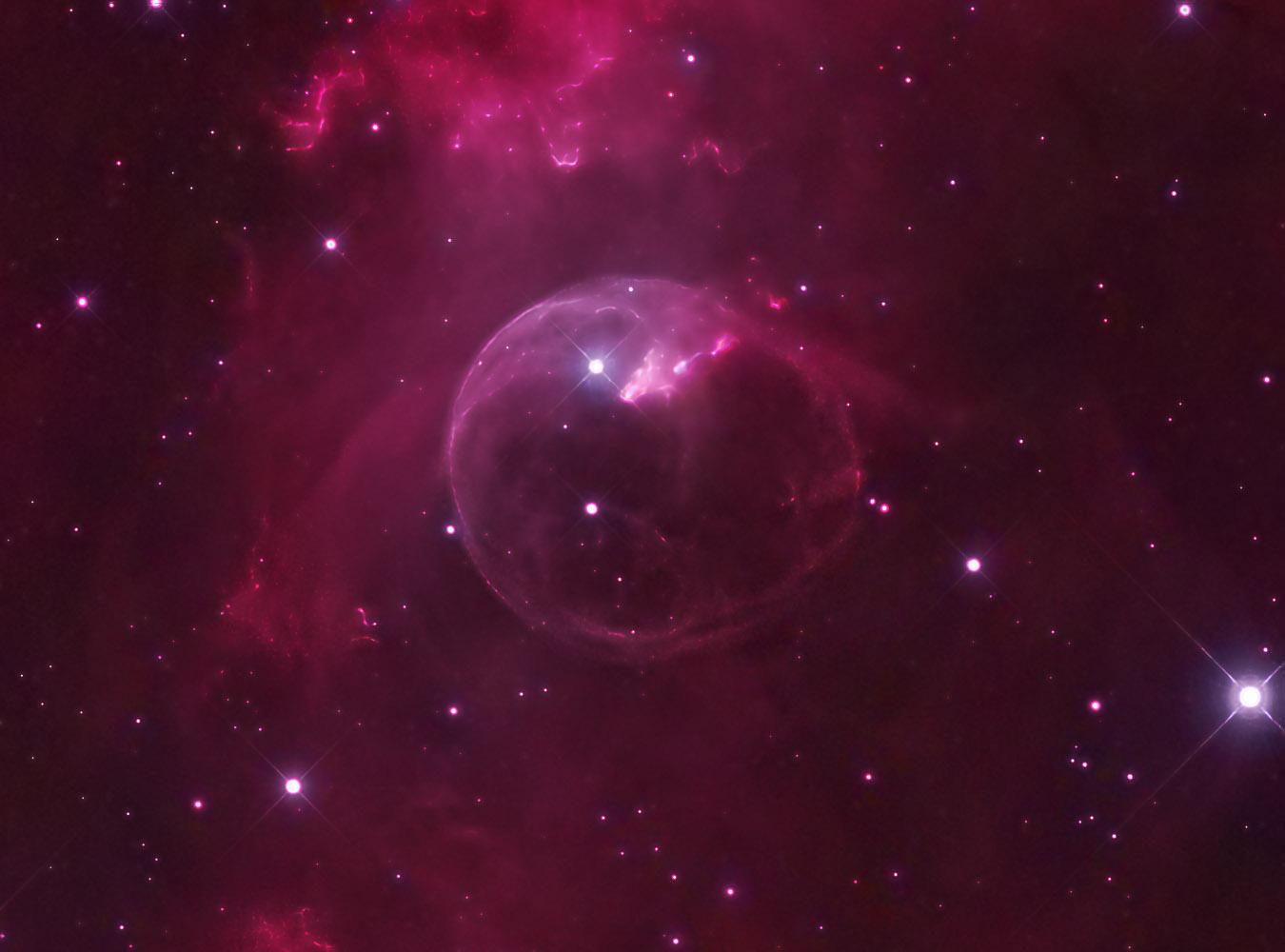 |
Bubble Nebula Nebula - RCOS |
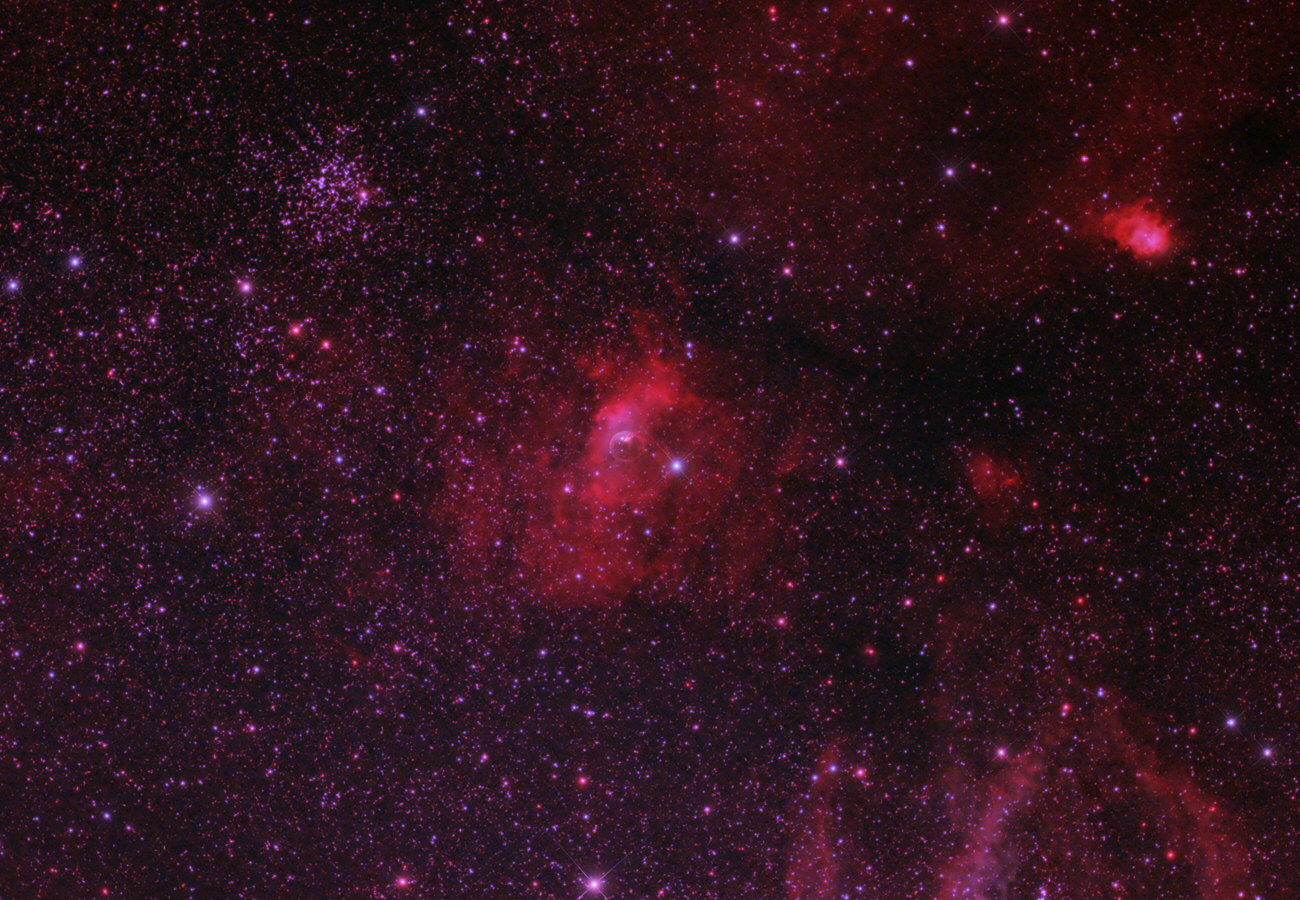 |
M52 and the Bubble Nebula Nebula - Takahashi |
NOVEMBER 4th, 2012Sharpless Sh2-171, (includes NGC 7822 & Cederblad 214) Huge object or objects really. The brightest central portion is NGC 7822, the patch on the top edge is Cederblad 214 and the odd shaped cluster towards the top right is NGC 7762. Again testing the 300mm lens - this time with 10 minutes exposures. Providing there is no Moon-light then 10 minutes seems better. Refocused the lens every hour and got some strange results - the internal focus affects distortion. Stacking was a nightmare! Image details: |
Sh2-171 |
OCTOBER 29th, 2012The Veil Nebula, NGC 6960, 6974, 6979, 6992 Various name for this supernova remnant over the years - Bridal Veil, Filamentary Nebula, Cygnus Loop, Pickering's Traingle....but generally known as just the Veil Nebula nowadays. Even a 300mm lens cannot fit in all of this huge supernova remnant in Cygnus. Blue/green denotes oxygen and red hydrogen. I was testing the lens for a more difficult target later in the year. The 5 minute exposures were a bit too short - I will run a test of 10 minute exposures in the future. Image details: |
Veil Nebula |
OCTOBER 22nd, 2012The Fetus Nebula, NGC 7008 One of the oddest looking planetary nebula around. The bright spot on the NNE edge is a low excitation knot known as Kohoutek 4-44. There is a raw Hubble image of this part. It is located in Cygnus The weather did not cooperate and it took 4 nights to get enough signal for this interesting planetary nebula. This object was too small for the Tak to producee usable RGB data so the Ha and OIII had to suffice. Image details: |
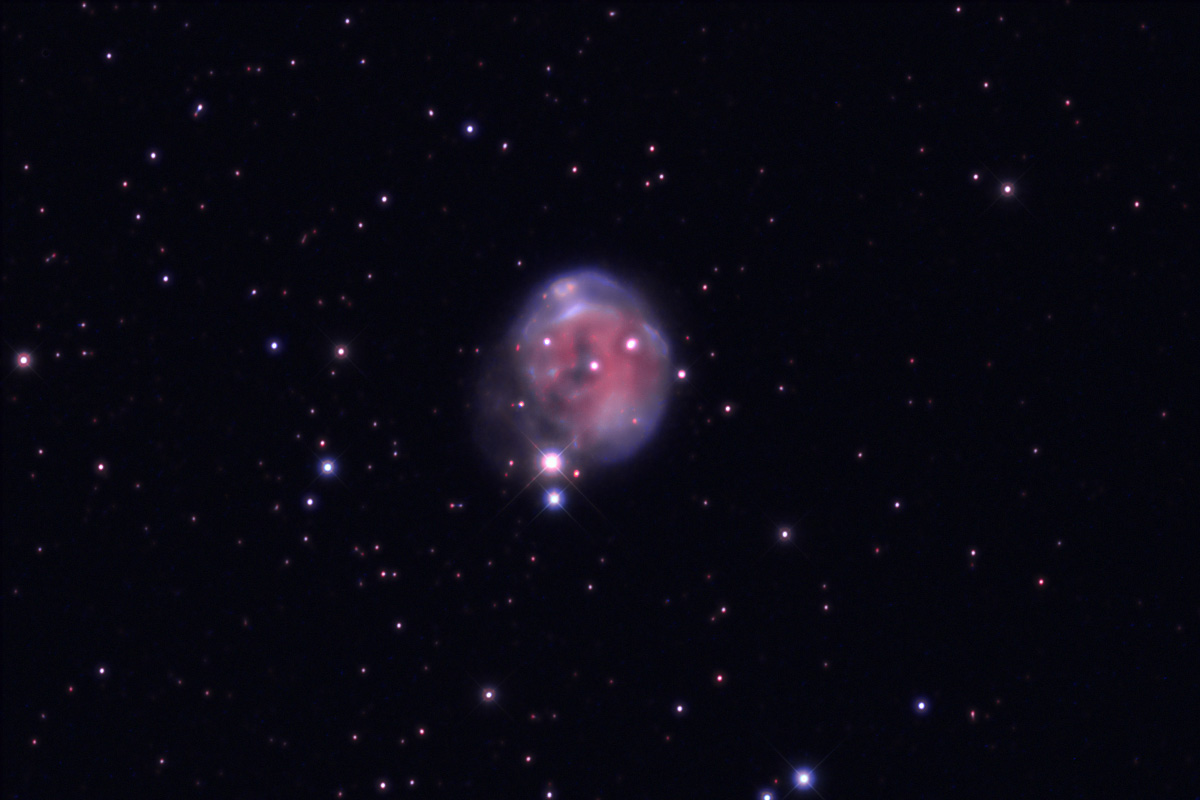 |
Fetus Nebula |
OCTOBER 15th, 2012Sharpless Sh2-132 (close-up 2 panel mosaic) An advantage of shooting simultaneously with two telescopes/cameras is you get the same object but at different scales. For the RCOS, I decided on a two panel mosaic to try and cover more of this big object. I shot the west panel before the meridian and the east after. As this part of the nebula is mainly H-alpha no OIII data was collected - colour coming from the wide-field image. Image details: |
Sh2-132 - close-up |
OCTOBER 7th, 2012Sharpless Sh2-132 (Wide-field) Rarely imaged sharpless nebula which is a bit of a challenge for a DSLR camera or least the outer reaches are. Unusually for a Sharpless object this nebula has a strong OIII signal (blue-green) which came as a bit of a surprise.
|
Sharpless Sh2-132 |
OCTOBER 2nd, 2012The Crescent Nebula, NGC 6888 An old favourite but one where I wanted to re-take with better OIII information. I could have done with twice the time but as usual the weather did not cooperate. Image details: |
Crescent Nebula |
SEPTEMBER 26th, 2012Lacerta from Kelling Heath The only other image I managed on our annual jaunt to the Kelling Heath Star Party. You just can't get the Milky Way's dusty brown colours from home. The light pollution filters knock them out. The image covers northern Cygnus and Lacerta up to Cepheus at the top edge. The huge dark nebula NNE of Deneb is prominent as are the bright North American/Pelican Nebulae. The emission nebula at the top middle is IC1396 with Herschel's Garnet Star on it top edge. The small (red/magenta) nebula near the top left corner is the Wizard Nebula.
|
Northern Lacerta and Cygnus |
SEPTEMBER 23rd, 2012Sagitta from Kelling Heath Taken on our annual jaunt to the Kelling Heath Star Party. Weather was good with several clear nights but I had camera problems - the Canon refusing to fire from either of 2 cable releases. So I admired the views instead - best was M13 in a 16-inch with an ETHOS eyepiece - wow! What a difference no light pollution filter makes! Sagitta just right of centre and Delphinus bottom left.
The coathanger is easy to locate but can you spot the Dumbbell Nebula? It's cyan coloured with a hint of red edges - pretty small at this scale though!
|
Sagitta |
SEPTEMBER 10th, 2012The Crescent Nebula, NGC 6888 (Widefield) Not the first image of the autumn session but the first I have been able tp process. Other images are awaiting clear nights to complete. This widefield image with the 4-inch Takahashi includes part of the Gamma Cygni Nebula (top) and the open cluster IC4996 bottom left.
|
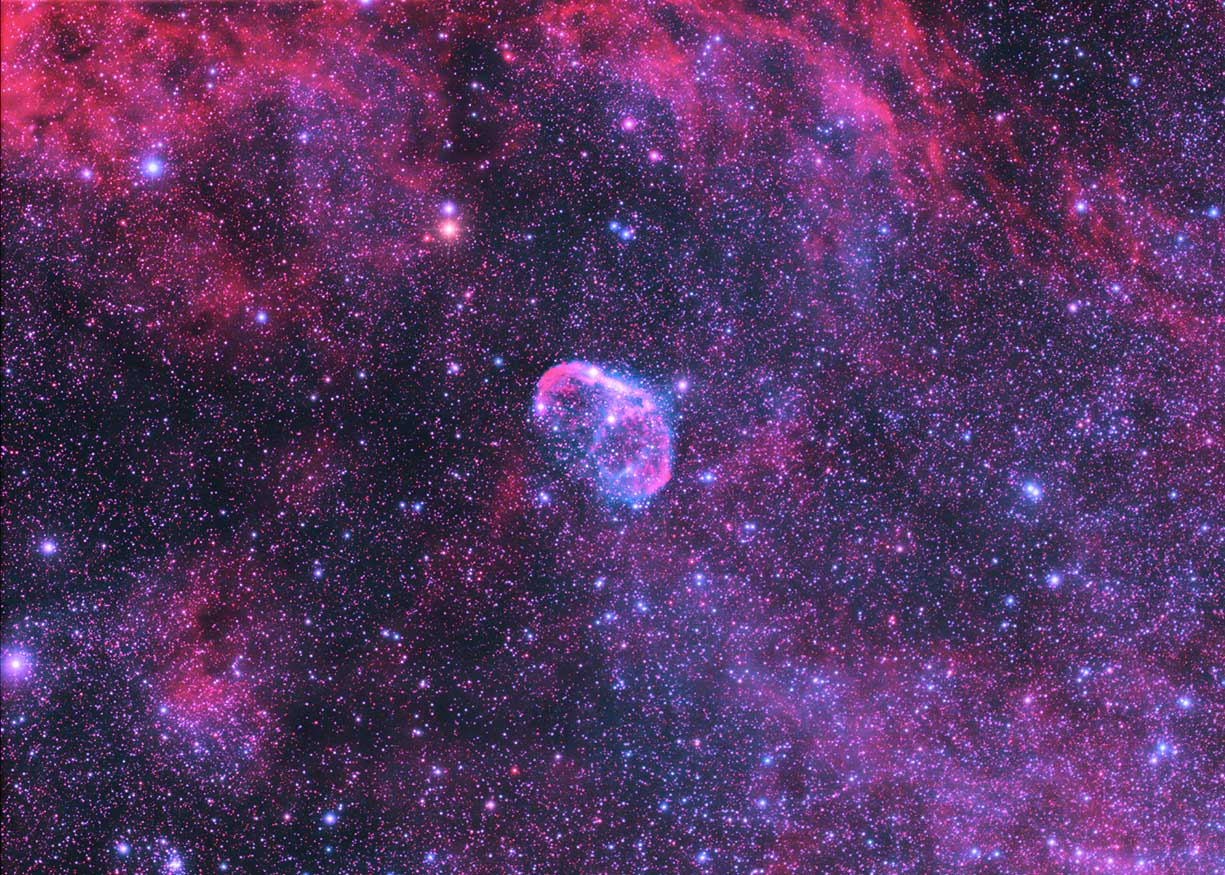 |
Crescent Nebula |
AUGUST 30th, 2012The Observatory Re-opens It's official - 2012 is the wettest summer for 100 years! However, it was no surprise that the first clear night coincided with full Moon! It was a chance to check things out after a 3 month shut-down. First target was the Crescent Nebula NGC 6888 and some Ha exposures were taken. I'll hopefully get another clear night for the OIII frames later. New for this winter is the Pentax 300mm lens with its own parallel guider (Astro Tech 66mm). Brian has mounted them on a losmandy dovetail plate which is interchangeable with the Tak. It's a really sturdy job with the 66mm offset for clearance purposes. The 300mm will give nearly twice the field of the Tak - ideal for larger objects.
|
|
MAY 27th, 2012Spiral Galaxy M101 and Supernova 2011fe Supernova 2011fe was discovered on August 24, 2011 by the Palomar Transient Factory, a research program run by astronomers at CalTech. It was still visible when I got around to imaging in April 2012, In my image is a unusual green/blue colour and quite prominent. Not sure if this colour is real or a consequence of the UHC filter I was using. It is towards the bottom (south) of M101, about 3/4 the way out. Imaging has now finished for the summer break - it simply doesn't get dark enough during the middle 10 weeks. Image details: |
M101 |
MAY 16th, 2012M105 Group Not the most inspiring of groups with two featureless ellipticals but it was one I had omitted imaging until it was recently required for a talk. My standard 20 minute sub-exposures burnt out the elliptical galaxy nuclei so a couple of 5 minute subs were used just for the their centres. M105 is the right-hand (westerly) galaxy, NGC 3371 is in the middle and NGC 3373 the blueish spiral to the left. NGC 3373 is probably a background object and not part of the Leo I group. Image details: |
M105 Group |
MAY 8th, 2012Arp 1 (NGC 2857) and Arp 285 (NGC 2854 & 2856) Originally published in 1966, The Atlas of Peculiar Galaxies is a catalog of peculiar galaxies produced by Halton Arp. A total of 338 galaxies (or quite commonly galaxy interactions as many are multiple objects) are listed in his atlas. You would imagine that the first entry Arp 1 would be the most peculiar of all but not so. It is a perfectly regular face-on Sc type spiral which Arp included because he thought it was of low surface brightness. It is compared to the interacting pair Arp 285, NGC 2854 and 2856, (lower right) but these are the "peculiar" ones, not Arp 1. Arp 1 is often referred to as Arp's Spiral. UPDATE: Supernova SN 2012fg in NGC 2857 discovered 7th October 2012 - Missed it! Image details: |
Arp 1 |
APRIL 29th, 2012Two Open Clusters, M44 and M67 Unusual targets for me but these images were required for a talk I was giving on the Constellations and their best deep-sky objects. M44, the Beehive Cluster, is visible to the naked eye from dark skies as a misty patch but it is all but invisible from Lancashire. Note the two red giants and two small background galaxies – one right of centre, the other towards the left edge. In contrast to the Beehive Cluster, M67 comprises mainly yellow-red giants with very few blue stars (known as blue stragglers). This gives away its age as one of the oldest open clusters known at around 4 billion years. Image details: |
The Beehive Cluster, M44
|
M67 |
APRIL 15th, 2012Ring Galaxy NGC 2859 NGC 2859 is classed as a (R)SBO galaxy, SBO denotes a barred lenticular galaxy and the R a ring. Lenticular galaxies are in effect armless spiral galaxies if that makes sense. It is located in Leo Minor. However, probably the most interesting aspect of this galaxy are the quasars found by Arp that lie close to NGC 3859's companions, one of which lies inside my image. This 19.2 magnitude quasar, designated U1, is adjacent to UGC5004 (the companion galaxy north of NGC 3859) and has a redshift of 0.23. This equates to a distance of 3 billion light years - approximately 12 times that of the galaxy. It is one of the objects Arp used to dispute the reality of quasar's redshifts. These views are almost universally discredited now and quasar's redshifts are accepted as a true indication of distance and the expansion of the universe. A feature of the full size raw image is the presence of literally hundreds of faint background galaxies around magnitude 20 - presumably components of a distant cluster(s). Image details: |
NGC 2859 |
APRIL 8th, 2012Sharpless Nebulae Sh2-254, 255, 256, 257 and 258 Continuing on the trail of the Sharpless nebulae this relatively unknown group in Orion caught my eye and with 5 objects for the price of one it was too good to miss. Shot with a 92% full Moon present, they didn't need a huge long exposure as they are quite bright - well at least they are for Sharpless objects. Image details: |
Sharpless Sh2-254, 255, 256, 257 and 258 |
APRIL 1st, 2012The Double Bubble Nebula, NGC 2371-2 The "other" planetary nebula in Gemini! Also known as the Peanut or Gemini nebula. Discovered by William Herschel and catalogued as two separate entries. Presumably he saw the two bright spots in the inner zone and these are what he recorded as two objects. The two outer lobes, from bi-polar jets, are probably far too faint to have been what he observed. The central star has a temperature of over 100,000K. There is a Hubble Space Telescope image of this object but it is frankly disappointing. Image details: |
NGC2371-2 |
MARCH 20th, 2012Lunar Geology (Selenology) Below is the image from my Astronomy Now article "Shooting the Moon in Full Colour", April 2012 magazine. The colour saturation has been boosted (using IRIS) to reveal the geology of the Lunar surface. The grid overlay has also been produced with IRIS. See the magazine article for the full details on how it was done and what the colours depict.
|
Lunar Geology |
MARCH 14th, 2012Reflection Nebulae Van den Bergh 67, 68 & 69 It took four nights between clouds and moonlight to get sufficient signal for this group of objects located in Monoceros. Sidney Van den Bergh published his catalogue of Reflection Nebulae in 1966 but, as is obvious from the image, the region is awash with red emission nebulae as well. Image details: |
Van den Bergh 67, 68 & 69 |
MARCH 7th, 2012Emission Nebulae Sharpless Sh2-207 & 208 Not the most spectacular of the Sharpless nebulae but with a 99% full Moon blazing away targets were a bit limited. The northern nebula is Sh2-207 - it's a bit like a mini-rosette nebula. The southern smaller one is Sh2-208. The remaining faint nebula in the image, including the faint wisp just to the west of Sh2-208, appears un-catalogued. They are to be found in Camelopardalis. Image details: |
Sharpless Sh2-207 and 208 |
FEBRUARY 26th, 2012The Crab Nebula, M1 I recently came across Rob Gendler's latest image of the Crab Nebula and immediately thought I need to do better! That image was taken with a 0.9 metre (3 feet) RC on a remote mountain top site but we can always try. As might be expected I couldn't get close but I ended up with a better image than before. Image details: |
Crab Nebula |
FEBRUARY 25th, 2012The California nebula, NGC 1499 . Image details: This bright emission nebula in Perseus is so named because it appears to resemble the outline of the US State of California. Just a quickie exposure for me at only 100 minutes. The magical UHC filter again. I am busy looking for a nebula in the shape of Lancashire - it's about time we one named after us!
|
California Nebula |
FEBRUARY 19th, 2012The Horsehead and Flame Nebulae A difficult object for me to image. It never rises high in the sky and is directly over the city of Manchester. In addition light pollution filters play havoc with the colours of the Flame Nebula which should have a yellow cast but of course this is precisely the wavelengths LPR filters block. Taken with the UHC filter again but still required some light pollution gradient removal - good old IRIS! Unusually for me, an image that is orientated with north to the left. Image details:
|
Horsehead Nebula |
FEBRUARY 12th, 2012Sharpless Sh2-212 with a UC HII region and YSO (star 228) A neglected but very interesting Sharpless emission nebula. Sh2-212 is a spherical HII region ionised by a central cluster. The latter is most evident in the infra-red where approximately 900 sources (stars) have been identified. However, probably the most interesting object lies near to its north-western edge where a Ultra Compact HII region is located. At its centre is a Young Stellar Object (YSO), also known as star 228. This YSO is high mass, around 14 solar masses and still growing, high temperature, around 30,000K, and high luminosity, approximately 17,000 times that of the sun. It has reached the main sequence so nuclear reactions have begun but it still has an envelope and disk from which it is accreting mass. It is a second generation star within Sh2-212 and appears to have formed in isolation. Reference: Deharveng et al, 2008. Image details: |
Sharpless Sh2-212 |
FEBRUARY 5th, 2012The Flaming Star Nebula, IC405 Resumption of trials with the UHC filter - it is certainly a cracking light pollution filter. The nebula is illuminated by the variable star AE Aurigae. It is a runaway star that was most likely ejected during a very close encounter of two binary star groups. This encounter, which is also credited with ejecting 2 other runaway stars, Mu Columbae and 53 Arietis, has been traced back to the Trapezium region of the Orion Nebula around two million years ago. Image details:
|
IC 405 |
JANUARY 29th, 2012The Crystal Ball Nebula, NGC 1514 (H IV.69) An important nebula in the history of astronomy as this was the nebula that caused William Herschel to change his mind as to exactly what was their nature. Until discovering and observing NGC 1514 (H IV.69) he thought all nebula were composed of stars he could not resolve but this one clearly looked like a star within a (gas) cloud. He coined the name Planetary Nebula and the rest, as they say, is history. He was both right and wrong. The nebula has nothing to do with planets but he was right that it was (is) a star embedded in a gaseous cloud. Not a bad deduction for 1790! Image details: |
NGC1514 |
JANUARY 22nd, 2012Spiral Galaxy NGC 1560 NGC 1560 is a relatively nearby dwarf Sd galaxy seen edge-on. It is part of the Maffei/IC342 Group. The latter is an important group just beyond the Local Group but our view is heavily obscured by the Milky Way. NGC 1560 is less obscured and has had its rotational curve measured twice which has a tantalising “wiggle”. Current estimates for the distance of this galaxy vary quite a lot but 12 Mly seems about average. Image details: |
NGC1560 |
JANUARY 14th, 2012Supernova SN2012a in NGC 3239 taken 13th Jan 2012 Sensational early discovery of a supernova by amateurs Bob Moore, Jack Newton, and Tim Puckett in the irregular galaxy NGC 3239. It is still brightening and my image shows it has now (13th Jan) probably reached mag 13? Image details: |
SN2012a |
JANUARY 10th, 2012The answer to life, the universe and everything is...... 37 The answer is written in the stars! A little light relief as I decided to image this famous cluster/asterism in the shape of the number 37. No deeper meaning here - just a bit of fun! Sometimes referred to as "IC37" it is in reality NGC 2169 in Orion. Miserable weaather seems to be continuing into 2012! Image details: |
NGC2169 |
JANUARY 1st, 2012Spiral Galaxy, NGC 772 (Arp 78) The terrible run of weather continued through December with effectively only one clear night. This odd galaxy in Aries was my target as it was one I had only taken in the early CCD days and a better image was needed. Not a spectacular galaxy being a 130 million light years distant but NGC 772 has a very unusual appearance and Arp included it in his Catalogue of Peculiar Galaxies. Close inspection reveals faint clouds around the galaxy particularly to the south near the companion galaxy. The odd appearance and surrounding clouds are probably the result of interactions with nearby galaxies of which 2 or 3 are visible in my image although none of them are very large. Image details: |
NGC772 |
|
Please remember these images are copyright David Ratledge. Contact me before any use is made of them. |
